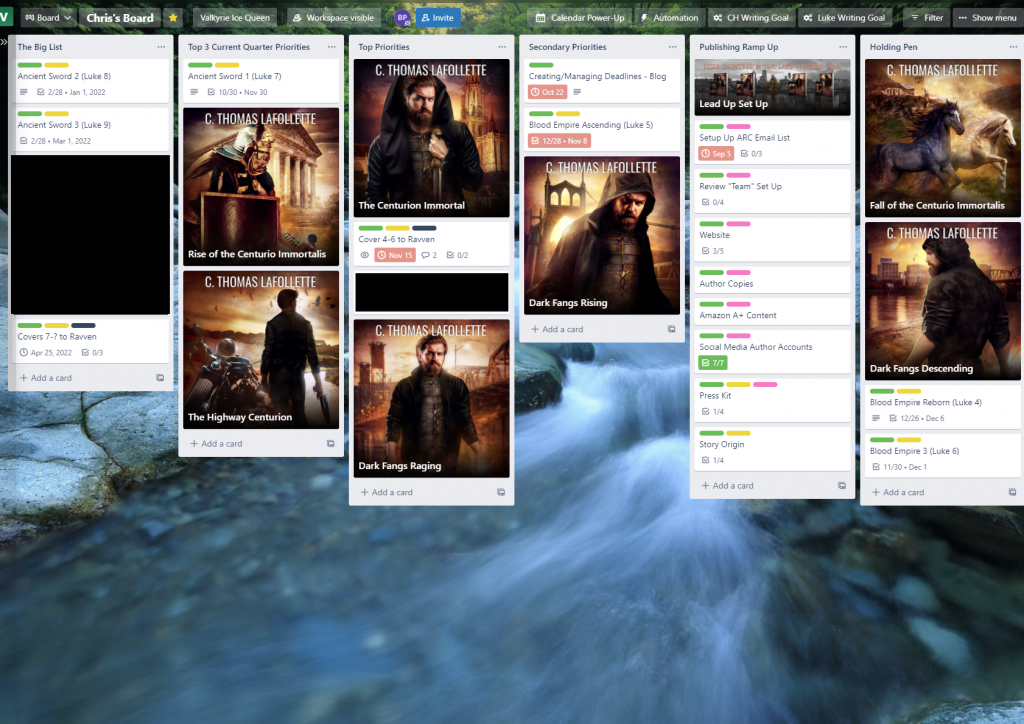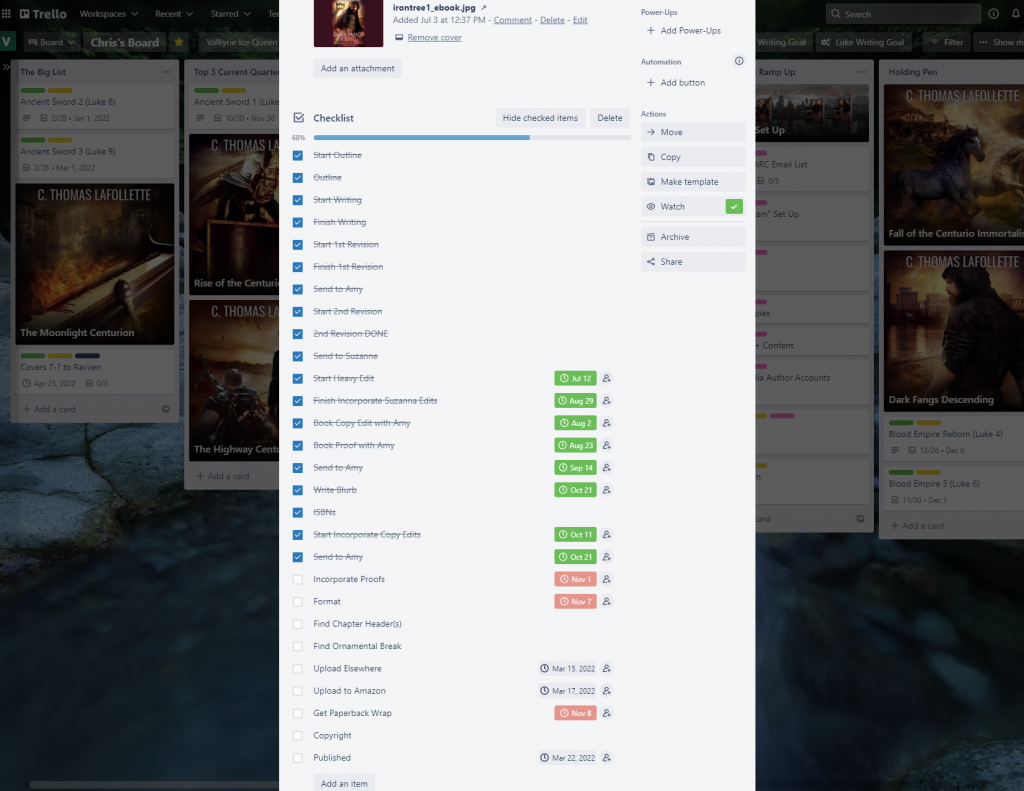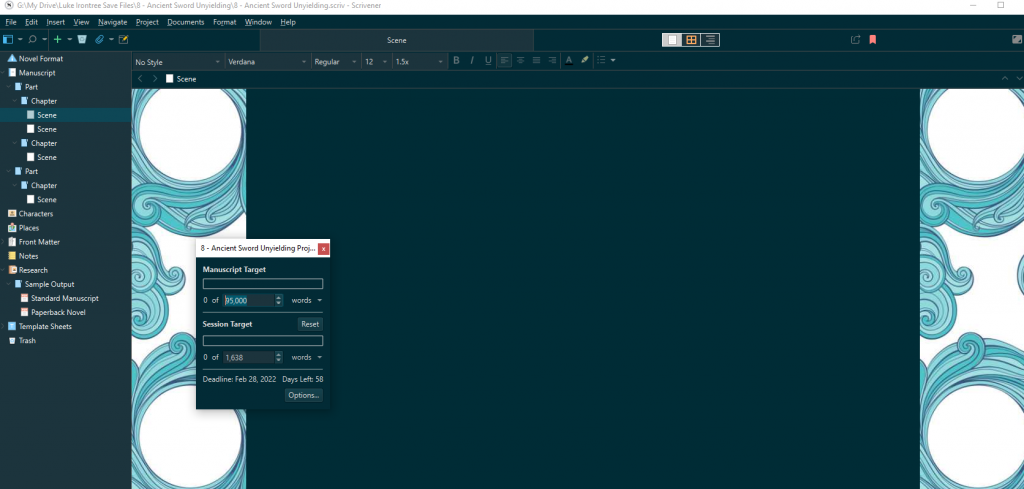Last time, I discussed my 2021 goals and how I set them. This time, I’ll go over some of the tools I’ve used to keep my writing on track. I’ve relied on a variety of tools and techniques to keep myself motivated and my writing moving forward. That’s been the key my success this last year–variety.
When it comes to writing, I’ve never put all my eggs in one basket. Writing is a mercurial pursuit. What’s working one day stops working the next, then works again later but in a slightly different way. By developing a variety of tools, you can change tactics when you find yourself struggling, which every writer does from time to time. And when you’re on deadline, having the tools to keep the words flowing will go a long way.
Writing Tracker
There are loads of writing trackers out in the world from programs to spreadsheets. The Excel sheet I use allows me to set a year’s worth of goals. Then I set individual goals each month based on the projects I’m working on. I like to track more than just my Work In Progress (WIP); I track blog posts, blurbs, or any other writing related project. Blurbs I assign to the actual WIP’s total while miscellaneous other words I put into a general bulk column.
The reason I do this is so I still feel like I’m making progress toward my end goal. Blog posts like this are all part of your brand as an author. Being able to put the word counts on the grid helps these words feel like they’re important and not a “waste of time” detracting from progress toward the overall goal.
Because I often work on multiple projects at once, even within the same day, I like to input the totals before I switch to the next project. Seeing the numbers on your chart go up provides a nice hit of accomplishment. And those little wins help keep you moving forward.
Trello

Trello has been a real boon to my organization. It’s ability to take big tasks and break them up into smaller tasks allows for a broad range of ways to keep motivated and organized. Essentially, it’s a digital white board that lets you put post-its or task cards on a a large board. You can organize it into various task levels designed to meet your needs. Then you can further subdivide your task cards even further. As a user, I’ve only scratched the surface of Trello’s capabilities.
It did take me a while to figure how I wanted to use it. The first couple of times I set up things then abandoned it. It wasn’t that I couldn’t figure out the program, I just didn’t figure out how best to organize it to fit my needs. It’s very powerful and flexible, but sometimes a wealth of choices can make it difficult to get it right for your needs. Once I found the right combo of tools to use, it became a huge piece of my success in 2021.
I’ve organized the lists into various categories to encompass different tasks as well as different priorities. I’ll lay out how the flow goes.
- The Big List – This is where I put everything when I create the card, then I move them to the various other lists when it’s time to get those projects into the flow.
- Top 3 Current Quarter Priorities – These are the big writing projects I want to work on for the quarter.
- Top Priorities – These are the cards that contain tasks I need to work on immediately.
- Secondary Priorities – These are the things that are in the queue to be worked on or are on-deck for the top priority list.
- Publishing Ramp-up – This is a separate list created for one special task: getting myself ready to publish a bunch of books next year.
- Holding Pen – These are projects that are at a middle point, such as after the draft is finished and I’m letting it sit before revisions, or while waiting to integrate edits. Once it’s time to get ready for the next task on a card, I move it either the secondary or top priority lists.
- Off-screen – I have a template form that I’ve built to create my book cards with all the sub-task categories I want so I don’t have to reinvent the wheel every time. There’s also a done pile for cards that have been completed.

Each individual Trello card can have several varieties of tasks and functions with in it. The ones I use most commonly are the checks list, due date, and description.
Tip – I typically only have word count marks at 25%, 50%, 75%, and finished. When I’m struggling and need the little endorphin hit of success. I’ll add in word count goals in between so I have a closer goal to achieve.
Remember, the name of the game is to use whatever method you can to get you to the end of the book. If you need to, add some easy goals so you have the boost of a victory. Or, rearrange your dates to give yourself more time. Keep flexible and keep moving forward.
The final piece of the Trello puzzle is the calendar. All those dates you’ve assigned yourself show up on the calendar so you can see what’s coming up. Trello is a powerful tool that’s really helped keep me organized and motivated.
Scrivener
Scrivener is the program I do my drafting in. It’s designed specifically for book writers and allows for a wide variety of tools writers can use to outline, draft, and organize a book. I like it way better than Word or Docs and have used it to write all my books. One of the small tools it has to keep you moving is the simple project tracker which sets up your project word count goal and your desired deadline. Once you put that in, it calculates how many words a day you need and adjusts it based on your output. You can even change the color of the progress bars to suit your needs. It’s a great tool to give you a realistic look at what you need to do for the day.

It’s not a big and all encompassing tool like Trello, but it’s one I use regularly. I like it visible at all times. I find it to be motivating, but it may not be for you. Use it when you want to or need to, but if it feels overwhelming, close the little window and keep going.
Organization, Motivation, Adaption
Throughout these two posts, I’ve intermixed both organizational tools I use and how I implement them into my writing life. For me, organization helps feed motivation. Breaking up big tasks into little tasks allows me a steady stream of little victories that keep driving me forward. Writing a book is often a long, lonely endeavor. Everything you can do to make it manageable will help you get to the end of your book. Having a variety of tools and methods will increase your chance of keeping the words flowing. And if the words stop flowing, having a variety of options to tinker with can help get you back on track.
Hopefully, one of these organizational tools can help you get to “The End.” Ultimately, it’s a common destination all writers are trying to reach, but there are nearly as many ways to get there as there are people attempting it.
What are your favorite ways to keep organized? How do you use those tools to keep yourself motivated and writing? Let me know if you have a question in the comments.
Please note, all the programs discussed in this post were paid for. None of them were provided for review or consideration of any kind.
[…] Continue to Part 2 […]